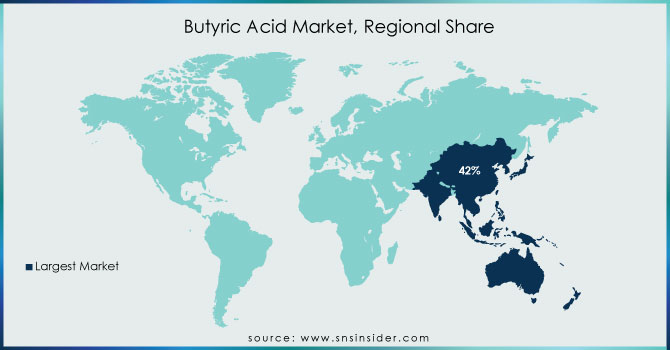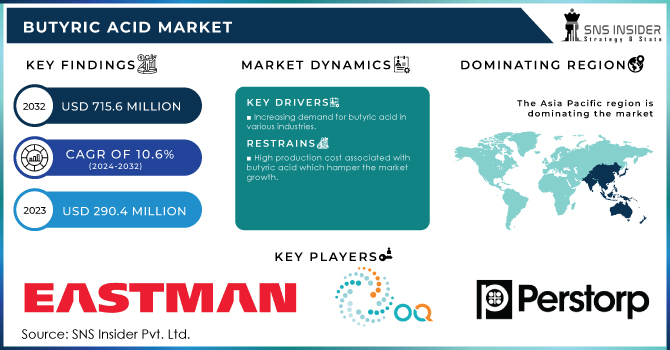Butyric Acid Market Report Scope & Overview:
The Butyric Acid Market size was valued at USD 290.4 Million in 2023 and will reach to USD 715.6 Million by 2032 and grow at a CAGR of 10.6% by 2024-2032. The butyric acid market is experiencing significant growth due to its wide range of applications across various industries. Butyric acid, also known as butanoic acid, is a carboxylic acid with a foul odor. It is commonly found in dairy products, such as butter, and is also produced by bacteria during the fermentation process. Despite its unpleasant smell, butyric acid has gained popularity in several industries due to its versatile properties. The global butyric acid market is witnessing substantial growth, primarily driven by its increasing demand in the food and beverage industry. It is widely used as a flavoring agent, preservative, and feed additive. In 2022, Eastman Chemical Company’s expansion, where the company invested in enhancing its production capabilities for butyric acid derivatives. This expansion was part of Eastman’s broader strategy to meet the increasing demand for bio-based and naturally sourced additives, particularly for food and animal feed applications.
Get E-PDF Sample Report on Butyric Acid Market - Request Sample Report
There is a growing demand for butyric acid as a key intermediate product in the synthesis of butyrate esters which are valuable chemical intermediates widely utilized in flavors, fragrances, and solvents. Being characterized by a unique smell, butyrate esters become more and more popular in personal care and cosmetics. They are employed for the production of various perfumes, lotions, etc., where the increased strive for natural and bio-based solutions is characteristic. The rise in demand for natural and bio-based fragrances aligns with the broader consumer trend favoring eco-friendly products, further driving the butyric acid market.
Moreover, the growth of the cosmetics and personal care industries in the EU is reported to be more than 4% annually according to data from the European Chemicals Agency. This regulatory and market-driven push for sustainable, safe, and naturally derived chemicals continues to boost the need for butyrate esters and, consequently, for butyric acid as a versatile chemical intermediate.
In 2023, Perstorp AB expanded its production capacity for butyrate esters to meet rising demand in personal care and cosmetics. This expansion supports the growing consumer shift towards eco-friendly and bio-based fragrances, underscoring Perstorp’s commitment to sustainable ingredient solutions.
Butyric Acid Market Drivers
Drivers
- Increasing demand for butyric acid in various industries
- Rising awareness regarding the health benefits associated with butyric acid consumption
Butyric acid, also known as butanoic acid, is a short-chain fatty acid that occurs naturally in various foods and is produced by certain bacteria in the gut. It plays a crucial role in maintaining gut health and has been associated with numerous health benefits. One of the key advantages of butyric acid consumption is its positive impact on the digestive system. It helps in maintaining a healthy gut by promoting the growth of beneficial bacteria and inhibiting the growth of harmful bacteria. Furthermore, butyric acid has been found to possess anti-inflammatory properties, which can be beneficial for individuals suffering from inflammatory bowel diseases such as Crohn's disease and ulcerative colitis. In addition to its effects on gut health, butyric acid has also shown potential in supporting weight management. Studies have indicated that it may help in reducing appetite and promoting feelings of fullness, which can aid in weight loss efforts. Moreover, butyric acid has been linked to improved insulin sensitivity and blood sugar control.
According to the U.S. National Institutes of Health (NIH), which reports that the global prevalence of inflammatory bowel disease (IBD) is expected to reach over 10 million cases by 2030. This increasing prevalence has driven interest in natural treatments like butyric acid, known for its beneficial effects on gut health and anti-inflammatory properties.
Furthermore, companies focused on new launches for instance, in 2022, Koninklijke DSM N.V.’s launched a specialized butyric acid supplement aimed at improving gut health. This product targets individuals with digestive health concerns, including those with IBD. Hence, the demand for Butyric acid is rising in the market.
Restraint
- High production cost associated with butyric acid which hamper the market growth.
It can be produced through chemical and biological means, both of which require substantial costs. Chemical synthesis is costlier because of the expensive raw materials, as well as the complexity of the processes involved in its production. Meanwhile, the bio-based production of butyric acid has been growing considerably due to sustainability concerns, but it is not free from certain costs either. The main technique used in bio-based production is the use of microbial fermentation, which needs significant equipment maintenance, as well as strict measures to control the environment in which the bacteria grow. The purity of the final product directly relies on the quality of these additional factors. Ultimately, the added costs translate to a more expensive end product. Because butyric acid is used in a wide range of industries besides food, reducing its cost of production without a significant reduction in the quality can be a significant challenge. Relying on innovation to reduce the cost of production while maintaining the end product’s quality may be a barrier to greater market adoption.
Opportunities
- Expanding applications of butyric acid in the pharmaceutical industry
Butyric acid, a versatile compound, is finding increasing utilization within the pharmaceutical sector. One notable application of butyric acid lies in its ability to enhance the bioavailability of certain drugs. By incorporating butyric acid into pharmaceutical formulations, the absorption and effectiveness of these drugs can be significantly improved. Furthermore, butyric acid has shown potential in the treatment of various medical conditions. Its anti-inflammatory and antimicrobial properties make it a valuable component in the development of drugs targeting specific diseases. The pharmaceutical industry is actively exploring the potential of butyric acid in the treatment of conditions such as cancer, inflammatory bowel disease, and metabolic disorders.
Butyric Acid Market Segmentation Overview
By Type
The synthetic type segment dominated the butyric acid market with a revenue share of about 62.3% in 2023. Synthetic production methods allow for greater control over the purity and consistency of the acid, ensuring a higher quality product. This reliability has made synthetic butyric acid a preferred choice for various industries, including food and beverage, pharmaceuticals, and animal feed. Additionally, in the animal feed sector, synthetic butyric acid offers consistent performance, which is crucial for maintaining livestock health and productivity. The reliability and scalability of synthetic production methods make them well-suited to meet large-scale industrial demands, thereby reinforcing the segment's market dominance.
By End-Use
The animal feed segment led the market with a market share of around 38% in 2023. The growth of the segment is triggered by the essential demand for increasing animal health and productivity. Butyric acid has been commonly used in animals’ nutrition for years due to its proven positive effect on their digestive health. It helps to promote the growth of beneficial naturally occurring bacteria in the animal gut, as well as the bioavailability of nutrients. Presently, with the globalization of the food industry and the increased demand for meat and dairy products, there is a strong international demand for animal-raising solutions. They should not only enhance the efficiency of livestock management, but also be safe and healthy for the animals and, consequently, for people. In the meantime, the world has become more aware of the dangers of antibiotic use in animals and introduced restrictions for its use in husbandry

Get Customized Report as Per Your Business Requirement - Request For Customized Report
Key Players in Butyric Acid Market
Raw Material Suppliers
-
US Biological Life Sciences
-
VWR (Part of Avantor)
-
ChemUniverse, Inc.
-
Kind Chemical
-
Riverland Trading, Llc
Butyric Acid Derivative Producers (Companies using butyric acid as a precursor)
-
OQ Chemicals GmbH
-
Perstorp Holding AB
-
Blue Marble Biomaterials
-
Tokyo Chemical Industry Co. Ltd
-
Alfa Aesar
-
Beijing Huamaoyuan Fragrance Flavor Co. Ltd
-
Snowco Industrial Co. Ltd
-
Palital Feed Additives B.V.
-
BASF SE
-
Kraton Corporation
-
Royal DSM N.V.
-
Evonik Industries AG
-
Solvay S.A.
-
Fuso Chemical Co. Ltd
-
Hawkins, Inc.
-
Hunan Huitong Chemical Co. Ltd
-
Penta Manufacturing Company
-
SABIC
Recent Development:
-
In April 2022, OQ Chemicals announced a price increase for n-butyric acid, which has taken effect from May 1, 2022, due to supply and demand factors.
-
In March 2022, Perstorp introduced Gastrivix Avi, a solution for gut health that combines the advantages of valeric and butyric acid. This innovative addition to Perstorp's range of broiler feed solutions follows the successful launch of Gastrivix Avi.
| Report Attributes | Details |
|
Market Size in 2023 |
US$ 290.4 Mn |
|
Market Size by 2032 |
US$ 715.6 Mn |
|
CAGR |
CAGR of 10.6% From 2024 to 2032 |
|
Base Year |
2023 |
|
Forecast Period |
2024-2032 |
|
Historical Data |
2020-2022 |
|
Report Scope & Coverage |
Market Size, Segments Analysis, Competitive Landscape, Regional Analysis, DROC & SWOT Analysis, Forecast Outlook |
|
Key Segments |
• By Type (Synthetic and Renewable) |
|
Regional Analysis/Coverage |
North America (US, Canada, Mexico), Europe (Eastern Europe [Poland, Romania, Hungary, Turkey, Rest of Eastern Europe] Western Europe] Germany, France, UK, Italy, Spain, Netherlands, Switzerland, Austria, Rest of Western Europe]), Asia Pacific (China, India, Japan, South Korea, Vietnam, Singapore, Australia, Rest of Asia Pacific), Middle East & Africa (Middle East [UAE, Egypt, Saudi Arabia, Qatar, Rest of Middle East], Africa [Nigeria, South Africa, Rest of Africa], Latin America (Brazil, Argentina, Colombia Rest of Latin America) |
|
Company Profiles |
Eastman Chemical Company, OQ Chemicals GmbH, Perstorp Holding AB, Blue Marble Biomaterials, Tokyo Chemical Industry Co. Ltd, Alfa Aesar, OXEA GmbH, Beijing Huamaoyuan Fragrance Flavor Co. Ltd, Snowco industrial Co. Ltd, Palital Feed Additives B.V. |
|
Key Drivers |
• Increasing demand for butyric acid in various industries |
|
Market Restraints |
• High production cost associated with butyric acid |


